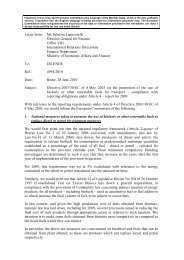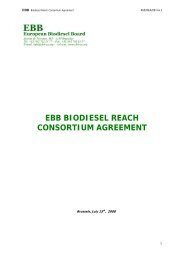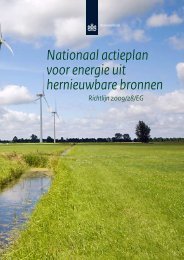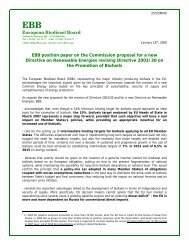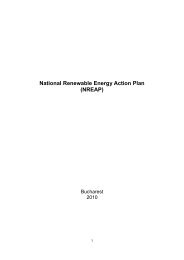EBB - European Biodiesel Board
EBB - European Biodiesel Board
EBB - European Biodiesel Board
You also want an ePaper? Increase the reach of your titles
YUMPU automatically turns print PDFs into web optimized ePapers that Google loves.
445/PRO/07 <strong>EBB</strong> REPLY to public consultation of DG TREN, April-May 2007<br />
1.3 Please give your general comments on the possible way forward”, and on how it could be<br />
implemented. Does it give an adequate level of assurance that biofuels will be<br />
sustainably produced? If you think the problem should be tackled in a different way,<br />
please say how, giving details of the procedures that would be used<br />
See general comments to section 1 above.<br />
With respect to the timeframe for implementation it would be necessary to have a pilot/testing period<br />
before implementing a system at EU level. Its adoption and its definition should be realised along a time<br />
frame of some years in a way to enable the industry and the other stakeholders involved to adapt their<br />
investments and their behaviour to the new reality.<br />
1.4 Carbon stock differences between land uses would be taken into account under criterion<br />
2. Should they also be taken into account under criterion 1? If so, what method should<br />
be used to determine how the land in question would have been used if it had not been<br />
used to produce raw materials for biofuels?<br />
As specified above, as a general principle <strong>EBB</strong> believes that for simplicity reasons the GHG (criterion 1)<br />
and land use criteria (criteria 2 and 3) shall be dealt with, assessed and monitored separately. In order to<br />
minimise confusion and overlapping, the eventual negative GHG impact of eventual biofuels or bio-energy<br />
cultivation on high GHG stock land such as peat lands etc. should be directly avoided by preventing the<br />
possibility to grow on these areas.<br />
1.5 As described in the possible way forward, criterion 3 focuses on land uses associated<br />
with exceptional biodiversity. Should the criterion be extended to apply to land that is<br />
adjacent to land uses associated with exceptional biodiversity? If so, why? How could<br />
this land be defined?<br />
Clear limits need to be defined according to scientific based assessments. Extending the application could<br />
entail additional unnecessary confusion on the definitions to be used. An extensive interpretation of the<br />
adjective “adjacent” could easily cover half of the known world. If aimed at further promoting biofuels<br />
and not at discriminating them, the system needs to be kept simple and proportional and exclude<br />
“indirect” impacts.<br />
1.6 How could the term “exceptional biodiversity” (in criterion 3) be defined in a way that is<br />
scientifically based, transparent and non-discriminatory?<br />
Its definition shall be internationally accepted and globally applicable. The Ramsar Convention 13 could<br />
provide a pattern definition for wetlands. Criteria of Annex I of the Convention on Biological Diversity 14<br />
and criteria and mechanisms for sites eligible for identification of “Special Areas of Conservation” of the<br />
EU Habitats Directive 15 could be considered as being land associated with exceptional biodiversity,<br />
however the last instrument is only applicable today at <strong>European</strong> level.<br />
2. HOW SHOULD OVERALL EFFECTS ON LAND USE BE MONITORED?<br />
2.1 Comments on the possible “way forward” as described in the consultation document<br />
The creation of a sustainability scheme for biofuels (and bio-energy) should suffice to avoid inappropriate<br />
land use. Since there cannot be an objective definition of indirect effects on land use, such a criteria<br />
should not be retained and the Commission should not be asked to report on this.<br />
13 Convention on Wetlands of International Importance especially as Waterfowl Habitat, of February 2nd 1971 (“Ramsar Convention<br />
on Wetlands”)<br />
14<br />
United Nations Convention on Biological Diversity of June 5th, 1992: Rio de Janeiro “Convention on Biological Diversity”<br />
15 Article 6 of “Habitats Directive” 92/43/EEC of 21 st May 1992 on the conservation of natural habitats and of wild fauna and flora.<br />
- 9 -



